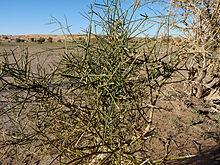
The Scrophulariaceae are a family of flowering plants, commonly known as the figwort family. The plants are annual and perennial herbs, as well as shrubs. Flowers have bilateral (zygomorphic) or rarely radial (actinomorphic) symmetry. The Scrophulariaceae have a cosmopolitan distribution, with the majority found in temperate areas, including tropical mountains. The family name is based on the name of the included genus Scrophularia L.

Zygophyllaceae is a family of flowering plants that contains the bean-caper and caltrop. The family includes around 285 species in 22 genera.

Cassia is a genus of flowering plants in the legume family, Fabaceae, and the subfamily Caesalpinioideae. Species are known commonly as cassias. The genus includes 37 species and has a pantropical distribution. Species of the genera Senna and Chamaecrista were previously included in Cassia. Cassia now generally includes the largest species of the legume subtribe Cassiinae, usually mid-sized to tall trees.

The Combretaceae, often called the white mangrove family, are a family of flowering plants in the order Myrtales. The family includes about 530 species of trees, shrubs, and lianas in ca 10 genera. The family includes the leadwood tree, Combretum imberbe. Three genera, Conocarpus, Laguncularia, and Lumnitzera, grow in mangrove habitats (mangals). The Combretaceae are widespread in the subtropics and tropics. Some members of this family produce useful construction timber, such as idigbo from Terminalia ivorensis. The commonly cultivated Quisqualis indica is now placed in the genus Combretum. Many plants in the former Quisqualis genus contain the excitotoxin quisqualic acid, a potent AMPA agonist.
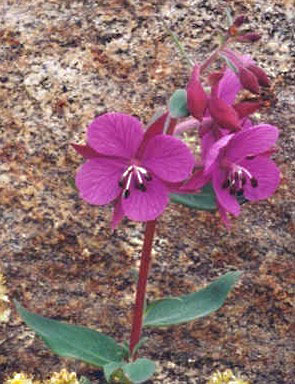
The Onagraceae are a family of flowering plants known as the willowherb family or evening primrose family. They include about 650 species of herbs, shrubs, and trees in 17 genera. The family is widespread, occurring on every continent from boreal to tropical regions.
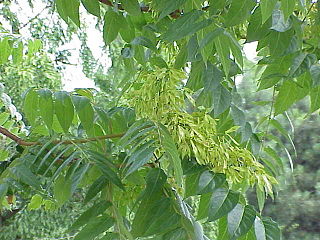
The Simaroubaceae are a small, mostly tropical, family in the order Sapindales. In recent decades, it has been subject to much taxonomic debate, with several small families being split off. A molecular phylogeny of the family was published in 2007, greatly clarifying relationships within the family. Together with chemical characteristics such as the occurrence of petroselinic acid in Picrasma, in contrast to other members of the family such as Ailanthus, this indicates the existence of a subgroup in the family with Picrasma, Holacantha, and Castela.

Nyctaginaceae, the four o'clock family, is a family of around 33 genera and 290 species of flowering plants, widely distributed in tropical and subtropical regions, with a few representatives in temperate regions. The family has a distinctive fruit type called an accessory fruit or anthocarp, and many genera have extremely large pollen grains.

Sterculia is a genus of flowering plants in the mallow family, Malvaceae: subfamily Sterculioideae. Members of the genus are colloquially known as tropical chestnuts. Sterculia may be monoecious or dioecious, and its flowers unisexual or bisexual.

Anisacanthus is a genus of flowering plants in the bear's breeches family, Acanthaceae. The generic name is derived from the Greek words ανισος (anisos), meaning "unequal," and ακανθος (acanthos), meaning "thorn." Members of the genus are native to tropical and subtropical regions of the Americas. They are commonly known as desert honeysuckles, though this term is shared with the genus Ancistranthus, and is something of a misnomer as true honeysuckles belong to the family Caprifoliaceae. Anisacanthus species are sometimes cultivated for use in xeriscaping.
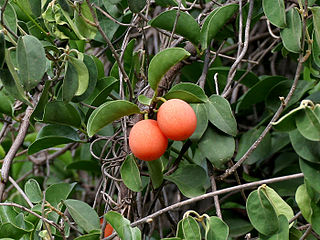
Ximenia is a genus of flowering plants in the family Olacaceae. The generic name honors Francisco Ximénez, a Spanish priest.

Korthalsella is a genus of flowering plants in the sandalwood family, Santalaceae. It contains about 25 species distributed in Asia, Africa, Australia, New Zealand, and some Pacific Islands.

Balanites aegyptiaca is a species of tree, classified as a member of either the Zygophyllaceae or the Balanitaceae. This tree is native to much of Africa and parts of the Middle East.

Tribuloideae is a subfamily of the flowering plant family Zygophyllaceae.

Funastrum is a genus of flowering plant now in the family Apocynaceae. The name is derived from the Latin word funis, meaning "rope", and astrum, alluding to the twining stems. Members of the genus are commonly known as twinevines.

Amoreuxia is a genus of flowering plants in the achiote family, Bixaceae. It was formerly placed in the family Cochlospermaceae. Members of the genus are commonly known as yellowshow. They are native to Mexico, Central America, Colombia, Peru, Curaçao, and the southwestern United States.
- Amoreuxia gonzaleziiSprague & L.Riley – Santa Rita Mountain yellowshow - Sonora, Sinaloa, Jalisco, southern Arizona
- Amoreuxia malvifoliaA.Gray - Chihuahua, Durango
- Amoreuxia palmatifidaMoc. & Sessé ex DC. – Mexican yellowshow - Mexico, Central America, Colombia, Arizona, New Mexico
- Amoreuxia wrightiiA.Gray – Wright's yellowshow - Curaçao, Peru, Chihuahua, Durango, Coahuila, Nuevo León, San Luis Potosí, Tamaulipas, Campeche, Yucatán, Quintana Roo, Campeche, Texas

Podranea is a genus of one or two species of African flowering vines in the family Bignoniaceae.
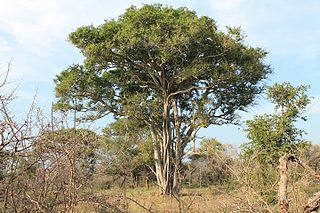
Balanites maughamii is a species of tree native to southern and eastern Africa. It ranges from Kenya through Tanzania, Malawi, Mozambique, Zambia, Zimbabwe, the Caprivi Strip of Namibia, Eswatini, and the Northern Provinces and KwaZulu-Natal in South Africa. It is deciduous or semi-deciduous, growing to 20 (–25) meters tall, with a rounded and spreading crown. It has a fluted trunk up to 1.3 m in diameter. It rarely grows as a low shrub 1.5 to 2 m tall.
Balanites glabra is a species of tree or shrub, classified either as a member of the Zygophyllaceae or the Balanitaceae. This tree is native to East Africa.
Balanites angolensis, or Angolan green-thorn, is a species of tree from southern Africa, it is a member of the caltrop family, Zygophyllaceae.
